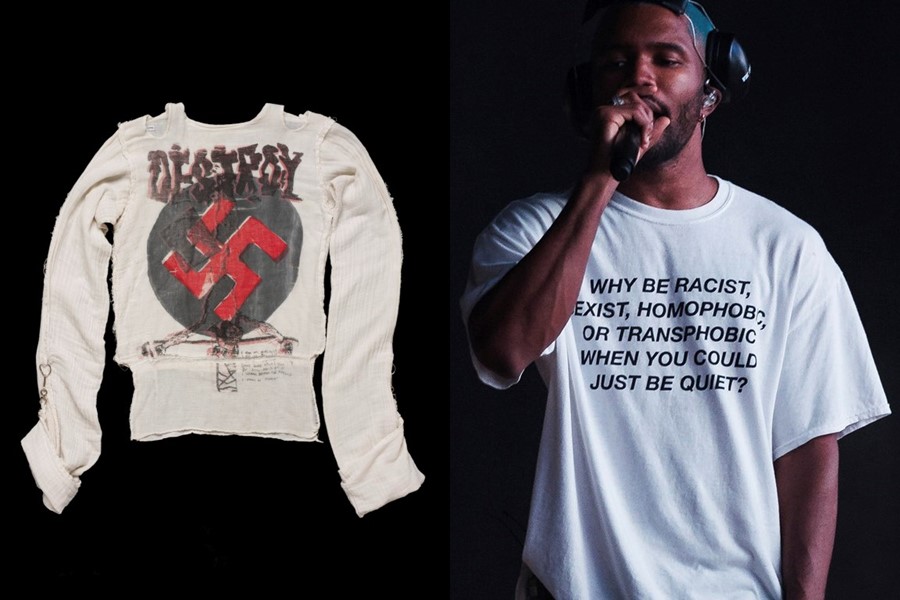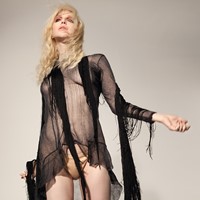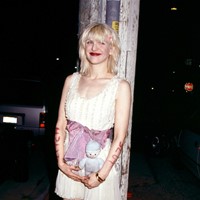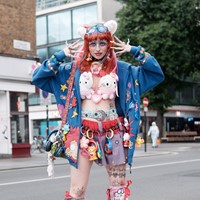How the humble garment became fashion’s Trojan Horse
The t-shirt is arguably fashion’s greatest leveller: the most popular and affordable item of clothing on the planet, it offers comfort and utility across all genders, classes and cultures. But at what point did the humble t-shirt become the Trojan horse of style, as a vessel for political discourse to sneak into our wardrobes?
A new exhibition opening this week at the Fashion and Textile Museum in London, T-Shirt: Cult, Culture, Subversion, traces the garment’s history all the way back to its beginnings, selecting key turning points in the relationship between the use of the t-shirt as political tool and wider social and cultural shifts. It becomes instantly obvious that the t-shirt’s role as a platform for sloganeering lies simply in being innocuous – like a second skin, it does away with any distractions that could otherwise undermine the impact of a punchy political statement.
It’s easy to mock the potential impact a t-shirt can have on politics. But as the exhibition makes clear, it’s a two-part process: using the wider awareness that a t-shirt can bring to a cause, then harnessing that attention to encourage others to incite real change. You have to start somewhere, and wearing your heart (quite literally) on your sleeve can force difficult conversations to take place in the open. As the grande dame of the political t-shirt, Katharine Hamnett, puts it: “a successful t-shirt has to make you think but then, crucially, you have to act.”
THE T-SHIRT’S HUMBLE BEGINNINGS
The history of the t-shirt has always been inseparable from social and economic concerns: initially developed by the U.S. Navy as a practical form of underwear that could be easily washed, this versatile new garment allowed uniforms to be worn for days in a row. From here it spread to other industries requiring manual labour, specifically agriculture and manufacturing. In this sense, the plain white tee has always been tied to social hierarchy, as the first uniform of the post-industrial working class – although ironically, the term ‘t-shirt’ was coined in the 1920s by that famous chronicler of America’s great and good: F. Scott Fitzgerald.
MARLON BRANDO AND JAMES DEAN MADE IT COOL
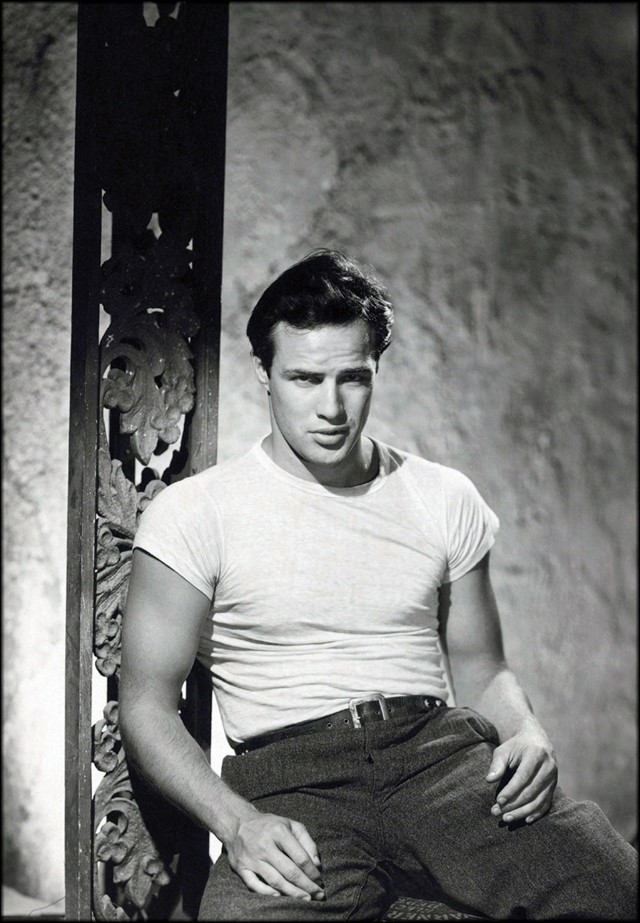
A major shift in how the t-shirt was perceived took place on the silver screen, with Marlon Brando’s performance as the brutish Stanley Kowalski in 1951’s A Streetcar Named Desire. The tight fit and rolled-up sleeves made for a tantalising show of Brando’s beefy torso and trunk-like biceps, ushering in a new era of the male star as sex object. While it no doubt played on stereotype and an unsavoury association of thuggery with the working class, along with James Dean’s 1955 turn in Rebel Without A Cause, it planted the seed for the t-shirt as the cultural renegade’s garment of choice.
THE HIPPIES TURNED TEES PSYCHEDELIC

Despite originating from the traditional fabric treatment techniques of Indian bandhani and Japanese shibori, the tie-dye trend only caught on in the West during the 1960s. As the Vietnam War raged on, American youth looked for a means of rebellion against the conservatism of their parents’ generation, moving towards traditional, hands-on techniques that corresponded to the emerging trends of new age philosophy and psychedelic rock. Plus, the patterns formed by tie-dye surely enhanced the effects of that other beloved 60s psychedelic recreation: dropping industrial quantities of acid.
VIVIENNE WESTWOOD USED IT AS A PUNK CANVAS
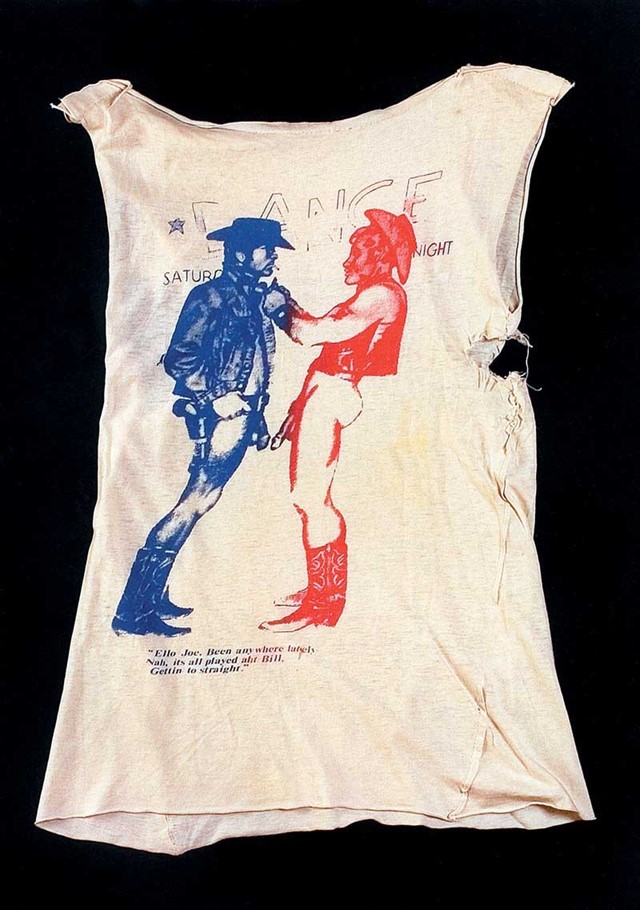
The next milestone for the t-shirt came in the 1970s, as Vivienne Westwood established her now legendary ‘SEX’ boutique on the King’s Road. While the punks of her generation were chopping off sleeves and fastening the rips in their tees with safety pins and badges, Westwood recognised the potential of the t-shirt as a blank canvas for more overt political messages. A number of her designs caused controversy, but a 1975 graphic of two cowboys touching penises actually led to the arrest of one of their shop attendants, who was stopped and later fined for “indecent exhibition” while walking through Chelsea – a dispiriting sign of how little British attitudes had changed towards homosexuality following the 1967 Sexual Offences Act.
KATHARINE HAMNETT CONFRONTED THATCHER WITH IT
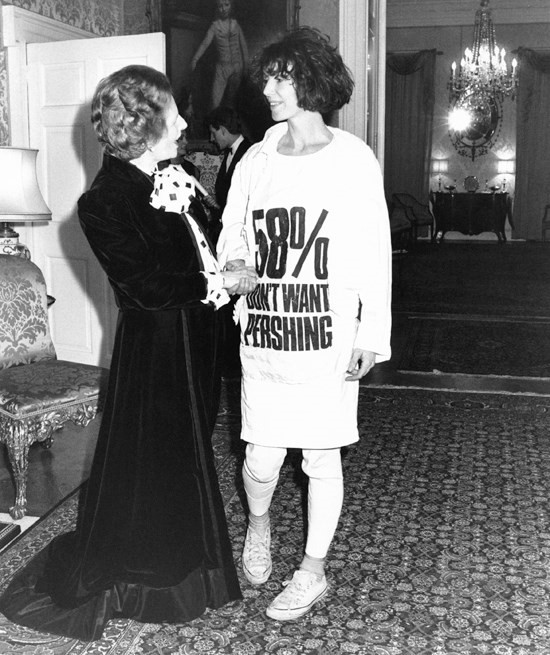
No history of the political t-shirt could go without mentioning Katharine Hamnett, who caused a stir in the 1980s with her impactful political slogans in bold type. During a decade of unbridled consumerism, Hamnett took the rhetoric of advertising and slyly refashioned it for liberal political causes. Her most famous moment took place upon being invited to a reception at the heart of British political life, 10 Downing Street. Sneaking a t-shirt in under her coat, she shook Margaret Thatcher’s hand wearing “58% DON’T WANT PERSHING”, a statement reiterating the public opposition to the Prime Minister granting the US permission to station nuclear missiles on British soil. The image ended up on the front cover of newspapers, bringing widespread attention to the Campaign for Nuclear Disarmament cause – according to Whitehall legend, it was one of the few times ministers ever saw the Iron Lady visibly rattled.
IT BECAME AN IMPORTANT TOOL IN THE FIGHT AGAINST AIDS STIGMA

The 1980s wasn’t just about hedonism: casting a tragic shadow across the decade was the worldwide AIDS epidemic, most notably in the West among gay and bisexual men. The stigma still attached to being outwardly queer in America led to the Reagan administration’s slow response to the crisis, so in 1987, six gay activists based in New York began putting up posters around the city and later disseminating badges and t-shirts – turning the public’s attention to what was being, on a governmental level, largely ignored. Inverting the pink triangle used to identify homosexuals in Nazi concentration camps, the t-shirts served as a stirring summary of their manifesto, which declared “silence about the oppression and annihilation of gay people, then and now, must be broken as a matter of our survival.” It was a watershed moment for queer visibility in the USA, and their work with ACT UP led to a speeding-up of the FDA drug approval time window, saving thousands of lives by allowing those living with HIV and AIDS to access experimental medicine.
IRONY TOOK OVER, AND IT STARTED TO LOSE MEANING
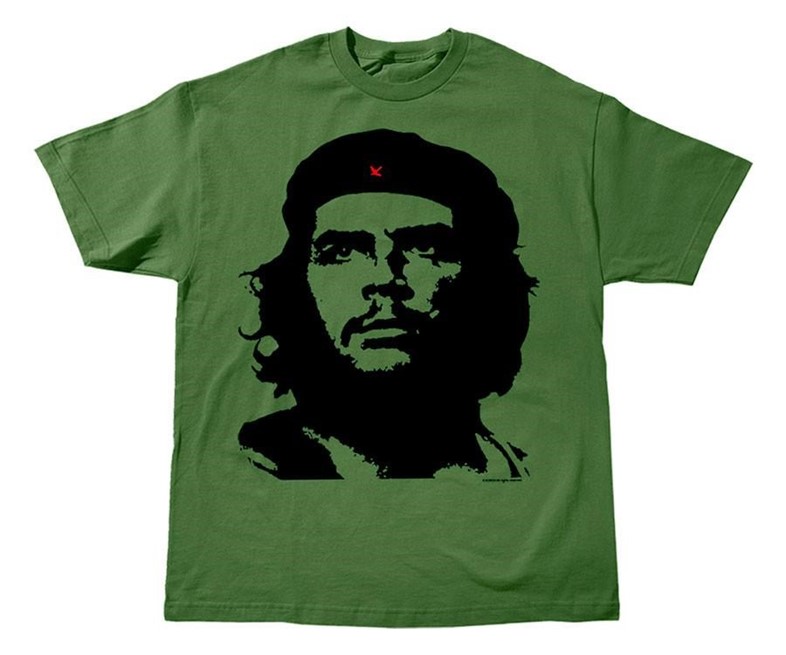
The 1990s and 2000s were more about ironic tees than direct political statements – take the war on drugs DARE designs, which were co-opted by youth and popped up on screen courtesy of filmmakers like Gregg Araki. The era’s most political t-shirt was also its least political: the one depicting Che Guevara, Cuba’s revolutionary guerrilla leader. We’ve already written the Secret History of the Che tee, but here’s the main takeaway: the original image by Alberto Korda was turned into a pop art piece by Jim Fitzpatrick which, after being mistakenly attributed to Warhol, achieved a kind of pre-internet viral status. In a very ironic moment, the image of the anti-capitalist revolutionary would go on to be sold on products by companies including Gap, Urban Outfitters, Belstaff, Vans, and Louis Vuitton.
FEMINISM BECAME FASHIONABLE, AND T-SHIRTS WERE THE MEDIUM
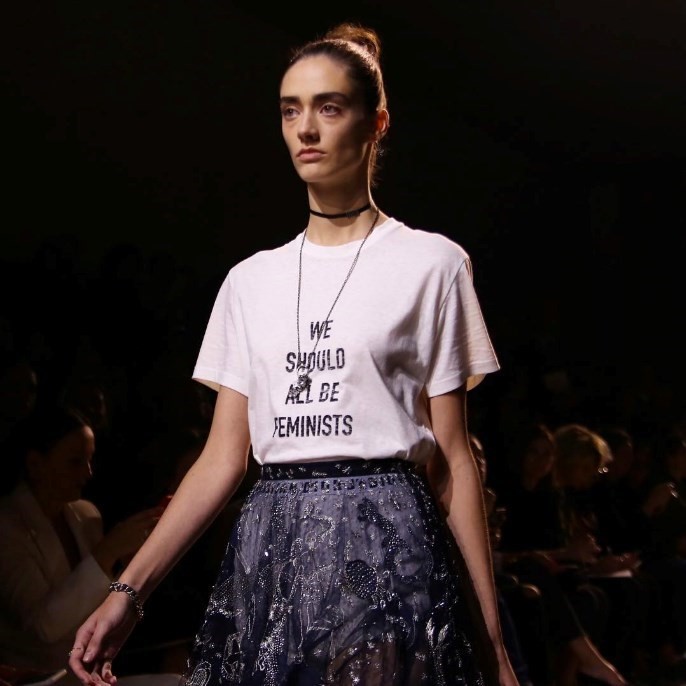
With the emergence of fourth-wave feminism in the 2010s, the t-shirt as political tool has undergone a revival, reflected in 2014’s ubiquitous ‘This Is What A Feminist Looks Like’ tee. Produced as a collaboration between ELLE and high-street chain Whistles, it foreshadowed the increasingly murky waters of ‘commodity feminism’: it later emerged that the t-shirts were being manufactured in Mauritian sweatshops, by women earning 62p an hour. A more complicated issue has been witnessing the absorption of the political slogan tee into the luxury market: is the political sentiment undermined by the price tag attached to it? For Maria Grazia Chiuri’s inaugural collection for Dior, she opened with a powerful statement, quoting Chimamanda Ngozi Adiche’s now seminal ‘We Should All Be Feminists’ essay on a t-shirt. The catch? It will set you back a cool £490 (this didn’t go down too well, so the house announced that a portion of the proceeds would go to to Rihanna’s Clara Lionel Foundation). See also: Balenciaga’s knock off Bernie Sanders t-shirt.
ITS REBELLIOUS SPIRIT REMAINS
A more accurate reflection of what a political slogan tee for today should look like comes by way of 18-year old designer Kayla Robinson, who began producing t-shirts via her upstart clothing brand Green Box Shop reading “Why Be Racist, Sexist, Homophobic or Transphobic When You Can Just Be Quiet”, paraphrasing a 2015 tweet by 18-year-old Brandon Male. Much to her surprise, she ended up being the focus of wider attention in August 2017 when Frank Ocean wore her t-shirt to perform at Panorama Music Festival, making international headlines as the t-shirt became a woke millennial must-have. With Robinson donating 50% of the $18.99 price to charity while guaranteeing ethical manufacture and the use of fair-trade fabrics, it’s socially conscious fashion that puts its money where its mouth is – and a sign that for a new and politically outspoken generation, the t-shirt could have an entirely new lease of life.
